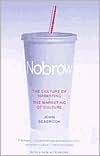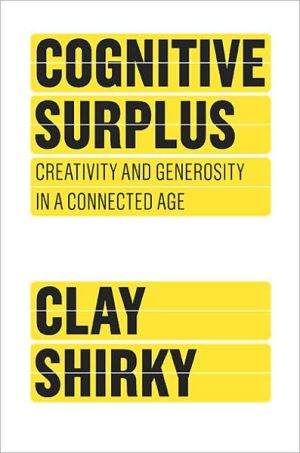Nobrow: The Culture of Marketing + the Marketing of Culture
From John Seabrook, one of our most incisive and amusing cultural critics, comes Nobrow, a fascinatingly original look at the radical convergence of marketing and culture.\ In the old days, highbrow was elite and unique and lowbrow was commercial and mass-produced. Those distinctions have been eradicated by a new cultural landscape where “good” means popular, where artists show their work at K-Mart, Titantic becomes a bestselling classical album, and Roseanne Barr guest edits The New Yorker:...
Search in google:
From John Seabrook, one of our most incisive and amusing cultural critics, comes Nobrow, a fascinatingly original look at the radical convergence of marketing and culture.In the old days, highbrow was elite and unique and lowbrow was commercial and mass-produced. Those distinctions have been eradicated by a new cultural landscape where “good” means popular, where artists show their work at K-Mart, Titantic becomes a bestselling classical album, and Roseanne Barr guest edits The New Yorker: in short, a culture of Nobrow. Combining social commentary, memoir, and profiles of the potentates and purveyors of pop culture–entertainment mogul David Geffen, MTV President Judy McGrath, Snoop Doggy Dogg, Nobrow high-priest George Lucas, and others–Seabrook offers an enthralling look at our breakneck society where culture is ruled by the unpredictable Buzz and where even aesthetic worth is measured by units shipped. American Journal Review - Carl Sessions Stepp Seabrook, a writer for The New York and Vanity Fair, delivers an amusing, perceptive backstage chronicle of what he sees as a major culture shift: the fusing of "highbrow" (elitism) and "lowbrow" into "Nobrow" (whatever has the Buzz).
Formerly the editor in chief of Alfred A. Knopf, and before that a wunderkind at Simon & Schuster, Gottlieb had been chosen by Newhouse to replace Shawn -- less than two years after Newhouse pledged he would keep Shawn as editor for as long as Shawn wanted to remain. Gottlieb, whose own cultural preferences ran higher than Shawn's -- he was a famously devoted patron of the ballet -- had taken on the almost impossible job of caretending Shawn's distinctions about what sort of culture was appropriate for New Yorker readers, while at the same time trying to make the magazine more commercial for Newhouse. Gottlieb tried to compromise with camp. Camp was a way of being hierarchically nonhierarchical -- of bringing highbrow connoisseurship to lowbrow pleasures, and thereby preserving the old High-Low structure of culture as status, though it was necessary to wittily invert it. Since taking over Gottlieb had published highbrow pieces about lowbrow subjects like Hollywood divas, Miami Beach, and a convention of the Wee Scots, who collect Scottie-dog memorabilia.\ \ I suggested that forty thousand words might be necessary to convey the complete gold-mining story in all its complexity and to flesh out the many charmingly eccentric characters I was sure to meet in the pursuit of my idea of an old New Yorker piece.\ \ "Great, that would be a two-part article," Bob responded cheerfully.\ \ I asked about the deadline. At the other places I had been writing, deadlines were much on editors' minds.\ \ "Oh, we don't have deadlines around here," Gottlieb said, frowning slightly, as if a faux pas had been committed, although his camp manner made it hard to tell if he wasbeing serious.\ \ "Work on it until you feel it's finished," he went on, "then we'll take a look."\ \ Risking an even greater faux pas, I asked, "And how much will I get paid?"\ \ "A lot," he replied. He didn't say how much. Just "a lot."\ \ If I needed money, I was to call the managing editor, Sheila McGrath.\ \ "Now, it's spelled McGrath but it's said 'mac-graw.'" Vague on all the usually important matters, Gottlieb was very precise on this point, which, although I didn't know it then, involved an elaborate in-house distinction between the people who said "mick-graath" and the people who said "mac-graw."\ \ And that was all. I went away, struggled, despaired, missed my self-imposed deadline, and finally wrote Gottlieb a letter explaining myself and asking for more time and money, which was swiftly answered with a phone call from Bob who told me to call Sheila McGrath. ("Now remember, it's spelled McGrath but pronounced . . .") Eventually I produced a twenty-thousand-word piece, and in less than a week Gottlieb called to accept it. The piece had no peg, of course -- pegs were part of the vulgar world of juuuuurnalism -- but it was an outdoors piece and felt springlike to Bob. In good time it was set up in type, meticulously fact-checked, beautifully edited by Bob and Nancy Franklin, and published in April at something like eighteen thousand words. It all happened just the way it was supposed to happen at The New Yorker. And that was the last time it ever happened quite that way for me.\ \
\ Carl Sessions SteppSeabrook, a writer for The New York and Vanity Fair, delivers an amusing, perceptive backstage chronicle of what he sees as a major culture shift: the fusing of "highbrow" (elitism) and "lowbrow" into "Nobrow" (whatever has the Buzz). \ — American Journal Review\ \ \ \ \ Publishers Weekly - Publisher's Weekly\ Culture in America is a lot more complicated than it used to be. Aimed at reinforcing class distinctions, the terms "highbrow" (signifying traditionally elite European culture) and "lowbrow" (meaning commercial culture aimed at the masses) were popularized by H.L. Mencken and Van Wyck Brooks in the century's first decade. In this breezy cultural analysis and memoir, Seabrook (Deeper: My Two-Year Odyssey in Cyberspace) delineates the subsequent blurring of the genres in U.S. culture. Drawing upon his experiences of writing for Vanity Fair and the New Yorker, Seabrook traces how "nobrow"--in which "commercial culture is a source of status, rather then the thing the elite defines itself against"--has radically changed how we view both high and low art. Setting his arguments against a tableau of rich and famous buzz-brokers--Talk magazine editor Tina Brown, studio head David Geffen, producer George Lucas--Seabrook manages to be simultaneously gossipy and insightful. Along the way he makes smart points about the role that social privilege plays in establishing taste, how advertising functions by validating social identity and how cultural hierarchies hinge more on power than on taste. Seabrook's mixture of the personal and the analytical is always animated and intriguing, but his analysis is so strong that, by the end, readers may wish for more meat and less memoir. Agent, Joy Harris. (Feb.) Copyright 1999 Cahners Business Information.\ \ \ Library JournalIn this ambitious and sometimes muddled undertaking, New Yorker writer Seabrook sets forth a case for Nobrow, his theory that high, middle, and low cultures have converged in contemporary America. Once the province of a snobbish elite, classical music has been relegated to the margins, while what were once subcultural phenomena such as hip-hop have been embraced by the mainstream. Along with this convergence comes the elevation of mass tastes. "In Nobrow, commercial culture is a source of status, rather than the thing the elites define themselves against," he writes. Seabrook embarks on a variety of digressions to make these points. He travels with rock wunderkind and flash-in-the-pan Ben Kweller of Radish, chronicles the metamorphosis of The New Yorker from sleepy to flashy, and hangs out at the private studios of George Lucas, whom he says represents the ultimate commingling of art and commerce. Though some of his theories tug at credulity--Tina Brown's ascendancy at The New Yorker may or may not represent a broader shift in the culture--his book rarely bores. But it also falls short of the seminal status it so clearly craves. Seabrook's reveling in urban culture feels too self-conscious, especially as he reveals himself to be a Soho-hopping elitist who spends $200 on a T-shirt and loves the sommeliers at 21. Thought-provoking but grating. [Previewed in Prepub Alert, LJ 10/1/99.]--Steven M. Zeitchik, New York Copyright 2000 Cahners Business Information.\\\ \








